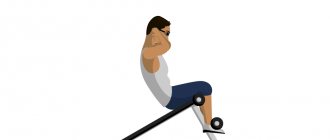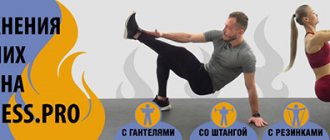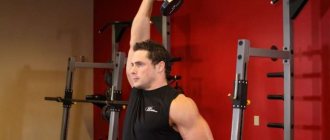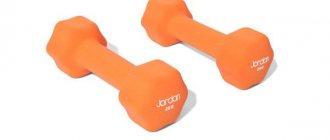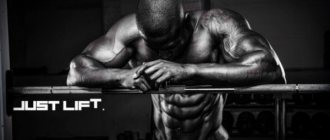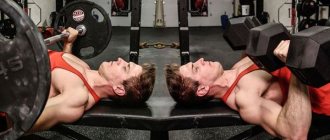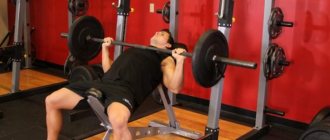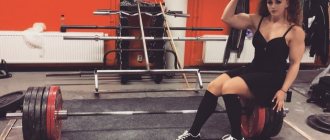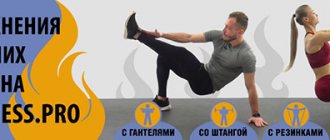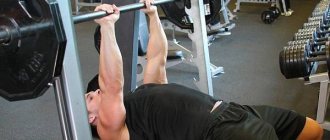Publication date: December 24, 2020.
Broad shoulders adorn both male and female figures. For guys, they are, first of all, an indicator of strength and masculinity, and girls like the fact that, thanks to wide shoulders, the waist seems narrower.
Conventionally, the shoulders can be divided into two hemispheres - front and back. The latter works when performing traction movements, that is, in those cases when you bring the weight closer to you.
The anterior hemisphere, accordingly, is used primarily when pushing the load away from the body.
This is exactly the movement that occurs when performing a seated chest press. Let's look at it in more detail.
What muscles work
The seated barbell press is one of the main exercises for working the deltoids. When performing this press, the following are involved:
- deltoid muscles;
- trapezoid;
- pectoral muscles;
- triceps.
Another advantage of this exercise, along with good shoulder training, is that it allows you to load the upper chest.
Since the upper part of the pectoral muscles lags behind in almost everyone, any exercise that gives the opportunity to work it will not be out of place in the training program.
The front deltas receive the largest part of the load during a vertical chest press; the lateral deltas are included in the work much less. In this case, you can additionally transfer part of the load from the anterior bundles of deltoid muscles to the lateral ones by varying the grip width.
What does it mean?
Although your working weight will be lower in standing presses, muscle activity of the deltoids will be higher by an average of 15.6%! This means that standing dumbbell presses are a great addition to your training program.
In addition, this exercise has one more advantage: in a standing position, you will have to spend strength to keep your body in an upright position. Your core muscles will work to stabilize your body. And strong core muscles are the key to progress in weights in almost all basic exercises - the same deadlift and squats.
Plus, with a strong core, the difference in working weight between standing and seated presses will be reduced, giving you an even greater advantage.
Execution options
Seated chest press
The main thing for this exercise is to place your hands on the bar slightly wider than your shoulders. However, depending on the individual anatomy, as well as the goals and objectives of performing the bench press, it can be slightly changed.
With a narrow grip, the front deltas work to the maximum. Wide, accordingly, allows you to transfer a significant part of the load to the side buns - it is perfect if your goal is wide shoulders.
Overhead press
This embodiment allows you to exclude the chest from work as much as possible, transferring almost the entire load to the deltoids.
At the same time, the lateral and even posterior bundles of the deltoid muscles, which are weakly involved when pressing the barbell from the chest, are more actively involved in the work.
Bent-over barbell press
This option involves performing bench presses while sitting on an incline bench. This technique allows you to give maximum load to the pectoral muscles. The required backrest angle is 30-45 degrees.
Advantages and Benefits of Dumbbell Bench Press
There are enough facts, relying on which, we can confidently say that presses can be safely classified as a very effective exercise for gaining mass. Here are a few main ones:
They help develop the muscles of both arms, eliminating any imbalances : the exercise helps to develop strength and endurance in both arms at once, without overloading one of them. For all people, one hand is always the dominant one, which can affect the technique and the process of forming muscle mass in the working muscles. This is not a problem until you notice differences in the size of your muscles or get injured. Using dumbbells instead of a barbell will eliminate this problem.
Less stress on the shoulders : The barbell press puts a lot of stress on the shoulder muscles. This is because the bar locks your arms in one position and you cannot rotate your wrists naturally. Dumbbells allow you to rotate your wrists, which takes pressure off your shoulders. Each arm can move freely through its range of motion, which also helps relieve stress on the shoulder joint.
Safe when training alone : each repetition performed with a barbell can be the last in terms of strength and endurance of the working muscles. At this moment, you can find yourself in a very dangerous situation, especially if no one is nearby. There are no such problems with dumbbells; you can simply throw them to the sides.
You can change the range of motion : you can do incline and regular presses with a barbell, but this requires a special bench, and not all gyms have one. To perform bench presses with dumbbells, a regular bench with varying inclination angle is suitable. A bench raised up will put more stress on the upper chest, and a bench lowered will put more stress on the lower chest. The flat surface allows you to evenly work on all parts of the chest.
Joint stability : during the exercise, you need to learn to control the weight - manage it. This results in greater activation of the shoulder girdle muscles and stabilization of the shoulder joints, which significantly reduces the risk of injury2.
Execution technique
Let's look at the technique of performing a seated chest press. Options for performing the exercise, which involve lifting the barbell from behind the head or in a tilted position, essentially differ only in the position of the arms and body.
- Take the barbell from the racks and take the starting position: sit on the bench with your legs wide apart and your feet firmly planted on the floor, the bar of the barbell is at your upper chest, your back and forearms are vertical, your chest and shoulders are straightened, your gaze is directed in front of you.
- As you exhale, quickly but smoothly straighten your arms, lifting the barbell up
- While inhaling, slowly, maintaining control over the apparatus and maintaining the correct trajectory of movement, lower the barbell down.
Don't forget that your joints should be well warmed up before starting the exercise. This will reduce the risk of injury to a minimum.
Particular attention must be paid to the shoulder joints, which, when performing a seated barbell press, receive a rather atypical load for them.
As for the negative phase of the movement: spend two to three times more time lowering the weight than lifting it - in this case, your muscles will grow at the fastest pace.
During this exercise, the barbell moves over a wide amplitude, therefore, if you want to increase muscle size and mass, you need to do from 6 to 12 (maximum 15) repetitions in one approach.
The exception is the overhead press: in this case, in order not to injure the shoulder joints, it is better to use less weight, doing 15 to 20 repetitions.
Use a bench with a backrest to provide good support for your core during the exercise. This will avoid a lot of stress on the spine, and will also help you concentrate on high-quality work of the target muscles.
Even if you do not have back problems, it is always better to choose between two exercise options - standing and sitting - the latter. When exercising with heavy weights, the spine experiences a lot of stress, and the consequence of this is a deterioration in its condition, which has a negative impact on the functioning of all organs and systems of the body.
Therefore, it is worth starting work in the gym by strengthening your back and, whenever possible, try to minimize the load to which it is exposed. If the bench also has a back, the load on the spine will be small.
Common mistakes
- The back and forearms should be positioned vertically during the exercise: do not tilt them forward or backward. If you have trouble keeping them perpendicular to the floor, use a Smith machine. You can also reduce the weight of the burden.
- If you are performing an overhead press, do not lower the barbell onto your shoulders in the lower position, this will take the stress off the muscles. The weight must be suspended throughout the entire approach.
- Also, when doing overhead presses, watch the position of your elbows: you don’t need to move them forward or back, they should be directed to the sides and down.
Working muscles during dumbbell bench press
The press is a horizontal pressing exercise. This means that your arms press the weight away from your chest, perpendicular to your body. Main muscles involved in this exercise:
- Large pectoral: Most athletes do the bench press solely to pump up the chest with dumbbells, so the load when performed correctly is very high. The main function of the pectoralis is horizontal flexion and medial rotation of the shoulder joint.
- Anterior deltoid: These work in conjunction with the pectoral muscles and are also involved in horizontal flexion and medial rotation of the shoulder joint. It's almost impossible to work on your chest without these muscles.
- Triceps brachii : The triceps, located on the back of the upper arm, is responsible for extending the elbow. The closer your hands are to each other, the more work the triceps have to do. The triceps are especially active at the end of the movement when you straighten your elbows.
- Shoulder girdle muscles: This group of small muscles, consisting of the infraspinatus, teres minor and subscapularis muscles, are responsible for stabilizing the shoulder. They are especially active during exercise because the weight can shift in different directions.
Correct technique for performing the exercise
To get the most out of any exercise, you need to do it correctly. Inaccurate technique reduces performance and increases the risk of injury. Let's take a step-by-step look at how to do the dumbbell bench press correctly:
- Sit at the end of a bench, holding a weight in both hands. Place the weight of the dumbbells on your thighs.
- Lie back and use your legs to lift the weight. Position yourself so that your back is flat on the bench, your arms are bent, and your weight is above your shoulders. Place your feet directly on the floor. Tighten your abs and slightly arch your lower back, pushing your chest forward.
- Raise the dumbbells up to arm length above your chest. Bring the dumbbells together at the top of the movement. Straighten your arms, but do not fully extend your elbows. Otherwise, the load will not be on the muscles, but on the joints.
- Bend your arms and lower them back down. Lower them as much as your flexibility allows. The lower you go, the more difficult and effective the exercise becomes. From the bottom of the movement, try not to make sudden movements to avoid injury.
- For your final set, either lower the dumbbells to the floor or, with your arms bent, simply sit down and return to the starting position. You can ask a friend nearby.
Video: how to independently and safely lift large weights of dumbbells for bench press
Choose the right training program
You shouldn’t grab old dumbbells and squeeze all the juice out of yourself right away. First you need to decide on the purpose of the workout, then the weight and number of repetitions. Use the following guidelines to help you find the right rep range and dumbbell weight:
- For Strength : 3-5 reps, pushing 85%+ of your one-rep max. Rest 3-5 minutes between sets.
- For hypertrophy (muscle growth): 6-12 reps, aiming for 67-85% of your one-rep max. Rest 60-90 seconds between sets.
- For muscle endurance : 13-20+ reps, working at less than 67% of your one-rep max. Rest 30-60 seconds between sets.
We recommend a home workout program for men to pump up muscles without going to the gym.
Not sure what your one-repetition maximum is? It's simple, the weight you choose should fatigue your muscles in a given number of repetitions. If you can't complete the required number of repetitions, then the weight is too heavy, but if you can do more than the specified number, then the weight is too light.
Interesting Facts
There are different versions of why this exercise is also called the army or soldier press.
According to the most plausible one, a similar exercise was previously used by soldiers who did it using a rifle as a weight.
According to another, the barbell chest press was called the military chest press because an athlete who performs it in a standing position with his legs together resembles a soldier standing at attention.
15 years ago, Australian scientists from the University of Queensland conducted research on various variations of the barbell bench press.
In their work, they described the nature of the load on certain muscle groups. Researchers have confirmed that the incline bench press targets the upper chest better than the flat bench press.
However, they found that there was actually little difference in the effectiveness of these exercises for targeting the upper pectoral muscles.
Australian scientists have also found that the upper chest is most involved in the work when using a narrow grip.
Extension of the arm with a dumbbell from behind the head
| Effect on muscles: Triceps: Long Bunch Triceps: Middle fascicle Triceps: Lateral bun |
Description
This exercise equalizes the development of the left and right triceps, emphasizing and thickening the top and middle of the triceps muscle. Also, it does a good job of separating the triceps heads from each other and separating them from the deltoid muscle.
Straightening the arms occurs in all sports that involve striking and throwing the sword from behind the head: handstands, gymnastics and acrobatics; pushing away an opponent in American football and hockey; punches forward and to the side from the body, in boxing and other martial arts; projectile repulsion; pole vaulting; Also, this exercise will be useful for tennis players, volleyball players and basketball players.
Exercise technique
Sitting on a bench, place your feet firmly on the floor. Straighten your back while holding a dumbbell in your right hand. Raise your arm with the dumbbell vertically up, your arm should be straight. Place the dumbbell behind your head, bending your arm at the elbow. The exercise is performed with a neutral grip - the little finger is higher than all the other fingers, and the palm “looks” forward. In the initial position, the elbow of the working hand should be directed upward, the torso should be in a vertical position, the back should be slightly arched in the lower back, and the gaze should be directed straight forward. Hold your breath by taking a deep breath. Squeeze your triceps and lift the dumbbell by extending your arm, keeping the top of your arm stationary. The movement should be performed only with the help of the elbow joint; all other parts do not take part in the movement.
When your arm is fully straightened at the elbow (this will be the top point of the exercise), hold your arm in this position for a couple of seconds and tighten your triceps even more and exhale. Smoothly bending your arm without relaxing your triceps, return the dumbbell to its starting position. After a short pause, proceed to the next repetition.
When you finish doing the desired number of repetitions with one hand, do the same number of repetitions with the other - this will be one approach.
Recommendations
If you round your back, this will cause your torso to lean forward, which means that the pressure on the spinal discs and shoulder joint will increase enormously. The back should remain straight and slightly arched at the lower back until the end of the set. During the entire exercise, the part of the arm from the shoulder to the elbow must be strictly fixed in a vertical position. If you do not do this correctly, the effectiveness of the exercise will decrease and the likelihood of injury will increase.
You can straighten your arm to the limit (that is, until it is fixed in the elbow joint) only when the arm is strictly perpendicular to the floor; if you are not sure that you can accurately determine this position, it is better not to straighten your arm to the end, otherwise there will be a very high probability of injury.
This exercise is unique. Its uniqueness lies in the fact that, depending on the angle of rotation of the forearm around its axis at the top point, you can work each of the triceps heads.
- If, during extension of the arm, the forearm remains in the initial position, and you do not turn it either inward or outward, and the palm faces forward, the long head is being worked out.
- If, while approaching the top point, you slightly turn your forearm so that your palm looks outward (away from the body), then the lateral head will be worked out.
- If you turn your forearm so that it looks inward, then the emphasis is on the inner head.
Regardless of which muscle you are working, make sure that your wrist is strictly fixed (not bent or unbent). Focus on the fact that the hand and forearm should be on the same line. If it is difficult for you to perform the exercise while sitting, you can do it standing.
Adviсe
- Choose the option for performing this exercise that suits you depending on your goals: the barbell press from the chest, from behind the head or in an incline position gives different loads on the muscles of the shoulders, chest and arms.
- Performing a military press with support on the back of a bench will minimize the load on the spine.
- Watch the position of the body and forearms: keep them vertical during the entire approach.
- Always maintain a slight arch in your lower back when performing barbell shoulder presses to help avoid spinal injuries.
One arm extension exercise
- Take a sitting or standing position and hold a dumbbell in your hand by a well-secured weight plate.
- Raise your hand up.
- As you inhale, bend your elbow and very slowly and smoothly lower the dumbbell behind your head.
- After a short pause, literally in two seconds, return your hand to its original position and exhale.
- During the entire training, it is worth monitoring the full contraction of the triceps. Also, when performing extension, you need to strain your abdominal muscles as much as possible and not arch your lower back.
- It is recommended to carry out this training in a sitting position on a bench with a backrest, which will help to properly fix the back and spine.
- This exercise can be performed by beginner athletes, but it is also suitable for professionals.
- It is better to do extensions in the second half of the workout, at a time when the body is well warmed up and not yet completely exhausted.
- The training can be performed in four sets of twenty repetitions.
Safe starting and ending position
The starting and finishing positions of the one-arm press are safer than other popular shoulder strength exercises such as front and lateral raises. The long leverage of front and side lifts often forces the scapula away from a stable position at the beginning and end of the movement. This is similar to lifting a crane off the ground before lifting a load onto a tall building.
Frontal and lateral raises cause more shoulder problems than any other exercise by targeting the muscles that try to hold the shoulder blades in relation to the neck and torso (the trapezius and rhomboids)..
The main role of the scapula is to support the arm. It can move freely to maintain the correct position of the glenoid fossa in relation to the head of the humerus. With a winged scapula (the medial edge moves away from the rib cage or tilts forward), or the medial/superior part of the scapula is higher than the lateral part, which places the glenoid fossa in a position that limits arm elevation. This is wrong and not stable. In this position, the scapula loses the necessary orientation.
The one-arm press, on the other hand, offers the correct position. With one-arm presses, the scapula is dynamically stable, there is unlimited freedom of movement with situational support and maintaining the correct position.
The movement begins in a rack position, with the kettlebell directly in front of the shoulder. The weight is located on the forearm, on the outside of the hand clenched into a fist, with the elbow pointing forward. The palm of the hand is directed towards the face. In the final position, the kettlebell is strictly above the shoulder, the elbow is straight. Both of these positions, initial and final, stabilize the position of the scapula.
Muscles involved in the exercise
- Deltoid muscles: anterior and middle bundles;
- clavicular part of the chest muscles;
- partially upper trapezius muscles;
- triceps (receive load due to extension of arms at the elbows)
- as well as the serratus anterior muscles.
Difficulty level: suitable for both beginner athletes as an analogue of the Army barbell press, and for more experienced athletes for multi-repetition training while working on relief, as well as increasing the intensity of training, “finishing off” the deltoid muscles at the end of the workout;
Advantages of the bench press Seated barbell press in the Smith machine:
- The ability to concentrate directly on the deltoid muscles, feeling the tension in them throughout the entire range of motion, without being distracted by maintaining the balance of the barbell (leaning forward or leaning back);
- Regardless of the level of weight load, the exercise is performed without the support of a partner, since the bar at the end of the approach is placed on special handrails and fixed with hooks on the machine.
Follow the correct technique for performing the exercise to target the deltoid muscles and eliminate the possibility of injury.
One-arm kettlebell press works for everyone
Whether you're looking to improve power and strength or are rehabilitating movement patterns, the one-arm kettlebell press fits the bill.
I have used this exercise to compensate for the high volume of throws, receptions, serves and contacts in international level volleyball and handball players. Athletes who consistently perform one-arm presses as part of their training program increase their punching power and endurance.
But even if you're just doing fitness, you can use it to improve your posture and increase shoulder strength.
The one-arm press is the best because it meets the following criteria:
1. Safe starting and ending position. 2. Safe movement pattern. 3. Development of “push” power. 4. Identifying and protecting weak links.
Now let’s explain in more detail each of the listed advantages.

